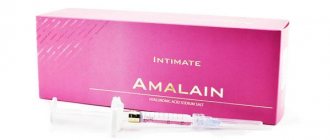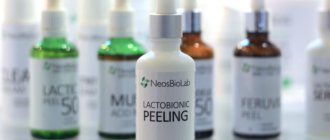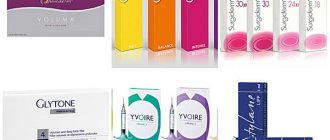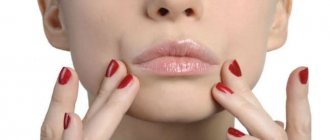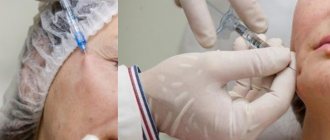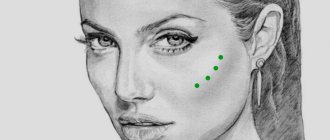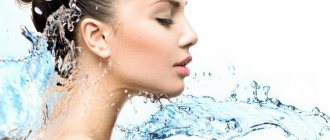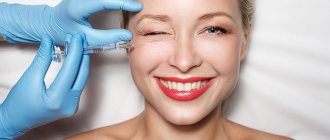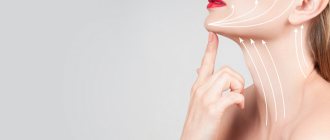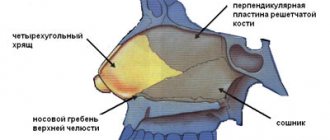McGregor's point:
1. Draw a line from the corner of the mouth to the outer edge of the eyebrow. 2. Draw a second line from the tragus of the ear to the nose. 3. The intersection of lines is the McGregor point.
MacGregor's point is a connective tissue complex that is the point of intersection of the masseter and zygomatic ligaments.
This anatomical formation is round in shape and measures 1-3 cm in diameter (depending on the size of the patient’s face). It is located in the thickness of the subcutaneous fat, immediately behind the attachment of the zygomatic major muscle to the bone. This point is a landmark for the location of the permanent perforator vessel and with age, due to sprain of the ligaments, it moves medially down by 0.5-1 cm.
Hinderer markings for cheekbone correction:
1. Draw a line from the tragus of the ear to the wing of the nose.
2. The second - from the corner of the mouth to the lateral bony edge of the orbit. The correction zone will be located in the upper-outer quadrant.
Marking according to Landau.
1. Draw a line from the tragus of the ear to the corner of the mouth; 2. The second line - from the tragus to the outer canthus of the eye; 3. The third - from the lateral canthus to the corner of the mouth. 4. Then, divide the line drawn from the tragus of the ear to the corner of the mouth into two equal parts. We connect this point to the opposite vertex of the triangle. 5. Draw a line along the most protruding part of the cheekbone parallel to the base of the triangle. 6. The intersection of lines 5 and 4 is one of the injection points. 7. Also, the injection points are the intersection of a line drawn along the cheekbone with the lines of the triangle.
Access point for cannula.
The distance from the lateral canthus of the eye to the middle of the tragus is divided into three equal segments; the border between the upper and lower two thirds is the access point.
Our address: St. Petersburg, Engelsa Ave., 30, 3rd floor, office 338-339 Opening hours: Mon - Fri: 10:00 - 19:00
Botox is a preparation of botulinum toxin, a natural protein, that helps smooth out facial wrinkles by relaxing muscles.
In the article you will find instructions for using Botox (botulinum toxin), learn how to use the drug, namely how to dilute 100 units (units) of the product with saline, how much to inject and whether one unit is enough, and also read how the procedure goes: where to inject (at what points on the face) and how to do it correctly according to the administration scheme.
The importance of correct input
Facial muscles are attached on one side to the bone tissue, and the other to the skin; when they contract, under the influence of nerve impulses, wrinkles remain on the skin.
The active substance botox penetrates muscle tissue, nerve fibers and blocks the transmission of nerve impulses, muscles relax and stop stretching the skin - wrinkles are smoothed out.
Therefore, it is important to know how to give injections with the drug correctly .
If you inject the drug into the wrong muscles, almost irreversible consequences will arise: from a distorted, irregular face to muscle paralysis - you will not be able to show emotions, because the muscles will not be able to transmit the nerve impulse.
Cheek contour contouring
Cheekbone contouring is an injection cosmetology technique aimed at facial rejuvenation and appearance modeling. The aesthetic and rejuvenating effect is achieved by introducing a volume-forming filler under the skin. The safe procedure does not require special preparation and takes from 10 to 30 minutes. The advantages of cheekbone contouring include: affordable price, no tedious recovery period, minimal number of contraindications and lasting aesthetic results.
Indications for cheekbone contouring
Cosmetologists actively include cheekbone contouring in comprehensive rejuvenation programs. The procedure gives excellent results in the prevention and elimination of cosmetic defects caused by age-related changes in the integumentary tissue. Thinning of the dermis and hypodermis due to involutional processes affects their elasticity, leads to deepening of folds and the appearance of wrinkles, sagging skin and deformation of the oval of the face. Similar changes occur in the integumentary tissues during the period of intensive weight loss. Efforts aimed at combating excess weight and excess adipose tissue in the body primarily affect the condition of the facial hypodermis. Many girls and women, in their quest for an ideal figure, encounter cosmetic problems such as increased severity of furrows, hollow cheeks, and deterioration of skin condition. The face takes on a painful appearance, but contouring of the cheekbones allows you to quickly correct the situation.
Indications for cheekbone contouring:
- Deformation of the oval of the face associated with involutional changes, which led to a decrease in the volume of soft tissues.
- Gravitational ptosis of the cheeks and skin of the malar area.
- Pronounced sweetness on the skin (nasolabial, lacrimal).
- The effect of “sunken” cheeks.
- Deterioration of the condition of facial skin associated with a decrease in its turgor and elasticity due to age-related changes.
- Individual characteristics
Cheekbone contouring is also carried out to model the appearance. With this cosmetic procedure, you can make the cheekbone area and facial features in general more expressive. Contour plastic surgery of the cheekbones allows you to emphasize the advantages of appearance, hide or correct congenital defects.
Photos taken before and after cheekbone contouring allow you to understand how effective the rejuvenating and modeling correction is.
Make an appointment
Usage diagram
Cosmetologists have developed a standard list of muscles and a scheme where Botox can be injected, including on the face, in order to achieve certain results or solve standard problems.
For eyebrows
Problem : wrinkles on the forehead, raised eyebrows.
Injection scheme : There are many different techniques for Botoxing the forehead muscles, but the most popular of them is the V-shape, which usually requires 12-20 units of Botox, which units we will describe a little later.
Read about Botox for eyebrows here.
For the face – maintaining shape
Problem : Deformed shape of the face and chin, uneven skin.
Administration regimen : Administer 4-6 units. intramuscularly into two symmetrically located skins on the chin, as well as into the cheekbones to maintain shape. To get rid of wrinkles on the entire face, Botox is injected into 20-25 points - near the mouth, eyes, forehead and nose, chin.
You can find out more about Botox for the face here.
For the eyes – getting rid of expression wrinkles
Problem : crow's feet.
Administration scheme : At the outer corner of the eye, 6-10 units of Botox can be injected both subcutaneously and intradermally - these two methods will be discussed later.
In the lower eyelid area, injections are carried out only intradermally, using a minimal amount of injected Botox - the skin there is delicate and requires maximum attention.
To raise the eyebrow, 6-10 units are injected above the eyebrow line, closer to the inner edge of the eye.
About Botox for the eye area is written in our material.
For nose and mouth
Problem : Tight muscles in the nose and around the mouth.
Administration scheme : The nasal muscle is blocked by injecting 1-2 units of botulinum toxin into 1-2 points. Perioral muscles - administration of 1 unit. Botox in 4 points above the upper lip and two points under the lower lip.
We wrote in detail about Botox in the nasolabial folds here, and here you can learn about Botox on the lips.
Neck area
Problem : unnatural neck shape, “turkey cords”.
Administration regimen : Administer 2 units. on both sides of the muscle cord at a distance of 2 cm between the injection sites.
Step-by-step instructions for use
Types of drugs
Now there is a large selection of drugs with botulinum toxin on the market, but there are several that are most popular among cosmetologists.
- Botox (Botox) - all drugs containing botulinum toxin are commonly called by its name, this drug is produced in the USA, the bottle contains 50-100 units (units) for dilution.
- Dysport , produced by Ipsen Biopharm, UK. Sold in bottles containing 300 and 500 units of botulinum toxin.
- Xeomin , made in Germany, containing 100 units of active ingredient per bottle.
Dosage
Botox is measured not in milliliters, but in units of action or simply in units. The price of one injection is determined based on the units injected into a particular area .
Based on the thickness of the skin in a certain area, fewer or more units are needed.
To eliminate horizontal lip folds, 14 to 24 units are required, for the upper lip, as we wrote above in the diagram - 2-4 units, the eyebrow fold requires 24-30 units - since it is deep. Based on the number of units, you can determine the price for the procedure that is required.
We suggest watching a video about the correct dosage of the drug:
How and with what?
Botox is diluted with sodium chlorine emulsion for injection, concentration 0.9%, the stopper with sodium chlorine is pierced with a needle, after treating it with alcohol, the required amount is injected into the container with Botox. The amount of saline solution is calculated based on the desired concentration of Botox (depending on the location of the procedure).
We invite you to watch a video about the principle of diluting botulinum toxin:
Description of the procedure
Botox is administered subcutaneously or intradermally, depending on the injection site. The difference between these two methods is described by their names - Botox is injected either into the skin or into the muscle that is located under the skin . The needles used are not large, often insulin, because of this the puncture is practically not felt.
We invite you to watch a video about how the botulinum toxin injection procedure takes place:
Temple area
RICE. 4: Scheme of injections for volumetric correction of the temporal region.
Previously, the temples were considered a kind of “taboo” zone for injection plastic surgery, since here a large number of neurovascular bundles come to the surface and there are cellular spaces delimited by fascia and aponeurosis. The use of a special cannula allows for safe volumetric correction of the temporal region, without which it is sometimes impossible to ensure proper aesthetic perception of the upper half of the face. The insertion point of the cannula is located on the border of the scalp or directly in it. After puncturing the skin with a needle and injecting the anesthetic, the cannula is immersed into the depth of the subcutaneous fatty tissue and slowly moves to the injection site. The drug is administered on the reverse stroke of the cannula by gradually filling the correction zone in a tunnel-like manner (Fig. 4). In the absence of allergies, it is recommended to use a filler containing lidocaine, which ensures maximum comfort of the procedure. Once the injection is complete, the implant is gently sculpted using massage to match the contour of the surrounding tissue. During one procedure, an average of 0.5-1 ml of the drug is injected into each zone.
Errors during
What errors can there be and how to fix them? Even if you contact a professional cosmetologist, mistakes and problems with the administration of Botox may arise - this is a very special drug, the administration of which depends not only on the area, but also on the type of skin, its condition, let's look at three typical problems, do not be afraid - most often everything goes well, but you need to be prepared for anything.
- Hypertonicity - a problem can arise when the drug is improperly diluted or administered into the desired muscle. We have already mentioned this problem above - when the face becomes like a mask - facial expressions are completely blocked, you cannot smile, and if the cosmetologist overdosed the dose of the drug, the patient may experience difficulties in eating food and swallowing saliva.
Solution : Even such a complex, at first glance, problem has its own solution - you need to speed up the resorption of the drug in the problem area. After Botox, there are certain contraindications, for example, thermal effects, but in this situation it will be beneficial - massage, physiotherapy, thermal effects will help reduce the concentration of Botox and restore the problem area. Swelling – everyone experiences it after Botox, it can be short-term (1-2 days), but sometimes it doesn’t go away even after a week. It happens that the swelling and swelling doesn’t go away for up to six months, the effect of the procedure is lost, and the face looks unhealthy.
Solution : Manual and hardware massage, thermal masks and microinjections of special medications into problem areas will help quickly remove Botox, stimulate activity and restore muscle mobility.
Asymmetry and ptosis - ptosis is a drooping of the upper eyelid, we talked about this above - it is very dangerous if the cosmetologist is not fully professional and is not familiar with the anatomy of the facial muscles.
Botox has the specificity of “migration”, a specialist should also be familiar with this and take this into account when injecting. Solution : In addition to the measures mentioned above to remove facial paralysis, doctors can inject Botox into another part to get a harmonious effect.
Chin
RICE. 5: Marking when performing volumetric modeling of the chin.
Injection correction of the chin is performed when insufficient volume is detected, which may be congenital or result from post-traumatic deformity. Previously, replenishment/increase of chin volume was performed only surgically using silicone implants, while postoperative swelling, hematomas, and long-term pain presented significant problems for the patient. With the advent of drugs based on stabilized HA, the chin modeling procedure has become simple, comfortable and fast - together with anesthesia, it takes no more than half an hour. The pronounced cosmetic effect lasts for two years. Before the injection correction procedure, the injection zone is marked - the midline of the face, the horizontal line of the chin, the area of chin augmentation, as well as the place where the needle is inserted during infiltration anesthesia are outlined (Fig. 5). The administration of the drug based on stabilized HA is carried out with a 21-23G needle. The drug is administered over the periosteum in microdoses of 0.1 ml to prevent its displacement. The fingers of the free hand control the volume and position of the injected drug. Filling of the mental groove (if necessary) is carried out at the level of subcutaneous fat by administering 0.1-0.2 ml of the drug. The maximum volume of filler used for chin correction is 2 ml. The identified asymmetry is corrected by introducing a larger volume or an additional injection during a repeat procedure. The duration of the aesthetic effect is 12-14 months.
